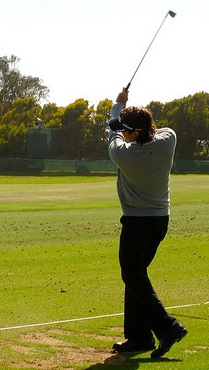Golfstead is reader-supported. When you buy through links on the site, we may earn an affiliate commission at no extra cost to you. Our affiliations include, but are not limited to, the eBay Partner Network and Amazon Associates.

How do I hit it farther? How do I gain extra yards? How do I increase my length on the golf course?
These are all variations of a very common question in golf.
Distance is one of the most, if not the most coveted asset in the game — off the tee, from the fairway, out of the rough, and even greenside depending on the situation.
In order to take the proper steps towards hitting the ball farther, it’s important to understand the elements of the club, ball and swing itself that determine distance.
Three of the most essential determinants of distance are the clubhead speed at impact, resulting ball speed, spin rate and launch angle.
There are countless ways golfers go about increasing their distance; in this article, I’ll be presenting and expanding upon several of them in a way that will hopefully be relatively easy to follow for the average golfer.
The idea is to first optimize clubhead and ball speed, and then optimize spin and launch angle.
First learn how to hit the ball solidly!
Note that I’ll be operating under the assumption that shots have been hit solidly.
One of the most straightforward things you can do to increase distance in golf is to reduce your mis-hit frequency and hit the sweet spot, since that is where the most ball speed is produced.

Before considering any of the ideas below, it’s very important that you work on making solid strikes (with minimal sidespin, which also affects distance) before taking the next step.
How exactly to go about hitting the ball solidly more consistently depends on the golfer, and it would be nearly impossible to offer a hard solution that applies to everyone.
You should first identify your area(s) of struggle and then look for solutions based on that; check out the tips and guides section as well as other how-to pages found on the site for more instructional content.
How To Increase Distance
1. Get stronger and more flexible.
This is one quite obvious way to increase your clubhead speed. Strengthening the muscles involved in the golf swing will allow you to swing faster on an absolute scale, and increasing your flexibility will allow you to get into the positions necessary (in the backswing and downswing) to maximize clubhead speed at impact.
While power and flexibility exercises can be readily found online, I will cover several effective ones below:
The Golf Squat
Hold a 10-pound dumbbell or other similar object in front of you in a hand-over-hand grip.
Position feet more than shoulder width apart, lower to a squat, and then rise while rotating the weight over your left shoulder. In this ending position, your hips should face left, your weight should be on your left foot, and your right heel should be off the floor.
Return to the starting position and repeat the exercise on the right side.
Benefits
- strengthens glutes
- strengthens and increases flexibility in the large muscles of the shoulders and back
Here’s a demonstration:
The 30-Second Speed Drill
Extend your arm directly in front of you at shoulder height.
Fully open and close your hand as quickly as possible for 30 seconds. Repeat with the other arm.
Benefits
- strengthens and increases flexibility of the muscles and tendons of the forearm, wrist and fingers.
The Core Crunch (With Ball)
Lie on the floor with a medicine ball between your bent knees. If you don’t have a medicine ball, you can use a towel instead.
Put your hands behind your head, supporting your neck but not pulling it.
Lift your shoulder blades off the floor until your head is a foot or so off the ground, and hold the position for a second or two. Lie back down and repeat.
You can also perform some similar core exercises which are illustrated in the video below:
Benefits
- strengthens the abdominal muscles which are essential for stabilizing the core during the swing.
2. Use the correct shaft flex.
It is generally believed that the correct shaft flex to use depends on your swing speed.
In particular, using a stiff flex with a swing that is too slow will typically result in overly low trajectories, while using a soft flex with a swing that is too fast will result in overly high trajectories with too much spin. In both situations, you will lose distance.
The relationship between swing speed and shaft flex is not the same for every golfer. Despite this, you should have a ballpark idea of what shaft flex you typically have the most success with if you’re not getting a complete club fitting.
Most shaft flex conversion charts associate an extra-stiff shaft with a driver carry of around 270 yards on average, a ladies flex with a driver carry of around 170 yards, and a regular flex with a driver carry of around 230 yards, with everything in between.
It’s not imperative to have a perfect shaft flex (especially for a more casual golfer), but it is something that can affect your trajectory and ultimately distance.
3. Generate more lag.
Another way to increase clubhead speed is to develop a good lag in the downswing. Lag occurs when the wrist remains hinged and the clubhead trails behind the body before impact, resulting in a “flicking” or “whipping” motion through the ball.
For help on generating more lag in the golf swing, I would recommend checking out the drills and tips in this article.
4. Use good golf clubs.
You’re probably missing out on clubhead speed if you’re using clubs that are too old, too heavy or too light.
Modern golf clubs like the TaylorMade Aeroburner driver have aerodynamic shapes that allow for reduced drag and faster swing speeds through the ball. They also have technologies that increase ball speeds across the clubface.
Using uncomfortably-weighted clubs can interfere with the natural rhythm of the swing and hamper clubhead speed.
Center Of Gravity
Aside from the above mentioned, you should also take into account the location of the center of gravity (CG) in the clubs and how it affects your trajectory.
In most cases, the goal is to have a minimum amount of spin combined with a launch angle that maximizes distance.
If you find that your spin rate and trajectory is too high, you should use clubs that have a low-forward CG to help reduce spin and lower your trajectory. Similarly, you should use clubs with a rearward CG if your trajectory is too low.
5. Use the right golf ball.
You should ideally use a golf ball with a compression rating that suits your driver swing speed so that you can squeeze out extra ball speed.
The table below serves as a loose guide for which ball should be used in certain situations:
| Swing Speed (driver) | Ideal compression for distance | Examples |
|---|---|---|
| 85 mph or less | Low to mid compression rating | Callaway Supersoft, Callaway Chrome Soft, Bridgestone Lady Precept, Nike RZN White |
| 85 - 105 mph | Mid compression rating | Bridgestone e6, Bridgestone Tour B330-RX, Titleist Pro V1x, Srixon Soft Feel |
| 105 mph or greater | High compression rating (tour, etc.) | Titleist Pro V1, Bridgestone e7, Callaway HEX Chrome, Bridgestone Tour B330 |
Beyond compression, a golf ball that promotes a low-spin flight with a mid-height trajectory will help to increase distance.
Like the golf club, you should take into account your current spin rate and trajectory and make the appropriate adjustments.
Check out the product reviews section for more information on golf balls that have your desired characteristics.
Conclusion
There are many things you can do to increase your distance, from making tweaks in your swing to changing your clubs and balls.
Follow the guidelines in this article and you’ll be taking big steps towards reaching that 300-yard mark or even beyond.
If you want to increase your distance and want more than just tips and guidelines, listen up. This is going to not only help you increase your driving distance by 15-20 yards in six weeks, but also develop the ideal body for golf which will make a difference in your entire game.
Thanks for reading. Are you unhappy with your length off the tee? Share your experience by leaving a comment below.




Great article! I feel like abs exercises are so important and even if someone is not looking to play golf, it will help them get more flexible and fitter!
Thanks. It’s true that core strength is extremely important, not only in golf — if you want to be a good golfer who can hit it a long way, it’s essential to be in shape — but in other sports and countless normal day-to-day activities.
Let me try and see how it goes… Swinging around 95-105 but cannot go more than that at the moment..